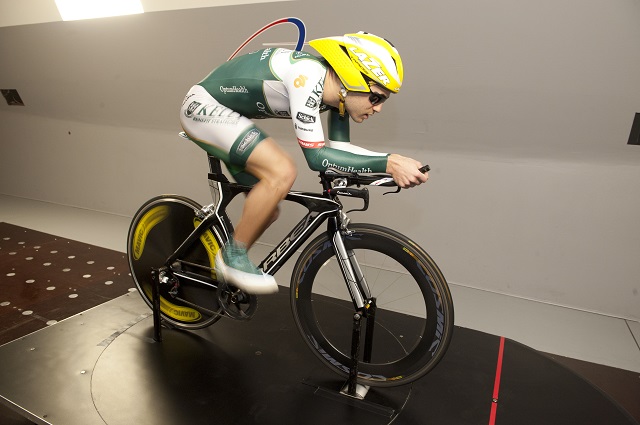Raising the bars: Raising your aero bars can help make you faster
Did you know that you can ride faster on your time trial bike by raising your position?

by Erica Carlson

Jan. 2011
This article first appeared in our June/July 2012 issue.
Did you know that you can ride faster on your time trial bike by raising your position? It’s a concept that Dr. Inigo San Millan introduced to Canadian Ryder Hesjedal’s Garmin-Transition’s team in the wind tunnel in 2010, and it may have led to their team time trial victory during stage two at the 2011 Tour de France.
When you test your time trial performance in the wind tunnel, you may only think about how to get more aerodynamic, by lowering your time trial bars or introducing equipment such as disc wheels, bladed seatposts and aero helmets. Traditionally, an engineer or aerodynamicist tests the coefficient of drag multiplied by frontal area (CdA) in the wind tunnel, which should produce the lowest, and in theory the fastest, position.
But according to Dr. San Millan, who is the Director of the Human Performance Laboratory at the University of Colorado Health and Wellness Center and a faculty member of the School of Medicine, testing for aerodynamics alone may not always be an accurate way to determine a rider’s optimal time trial position. Dr. San Millan’s latest research suggests in order to find the position that will produce the best time trial performance, you must not only consider how low the rider is but also their ability to function for a harder and longer workout while maintaining such a position. Sometimes the fastest, not necessarily the lowest, position can be too stressful for the body, increase lactate production in the muscles, make it hard to sustain power output and hinder your performance.
Dr. San Millan began looking at metabolic responses to different body positions on the time trial bike back in 2006. He used this research to help professional and recreational riders optimize their position. “I started testing the metabolic output of riders and observed that some of the fastest, most aerodynamic positions were more tasking on the rider, metabolically speaking,” says San Millan. “These positions were therefore making them slower, especially in a longer time trial. What I realized is that maybe the second or third most aerodynamic position, which was very close to the most aerodynamic position, was actually easier on the metabolic system of the rider. This position was therefore, in practice, the most functional and ideal for the rider.”
When testing his riders in the wind tunnel, Dr. San Millan takes their heart rate and blood lactate levels and compares them to varying degrees of low time trial positions. He gradually increases the wattage to find the “crossover point” between the height of the rider’s position on the time trial bars and how well the rider can metabolize lactate. He has worked with seven professional cycling teams over the past 15 years and his time trial research was done with Garmin-Transitions, Saunier Duval and UnitedHealthcare, in three different wind tunnels around the world.
Three ways to improve your time trial technique
When asked about what three things that a time trialist can do to improve their technique, and therefore performance, even without a trip to a wind tunnel, Dr. San Millan says to start with some basics. “First, I would say stay low, but not too low, with your head tucked in. The lower you are, the more aerodynamic you are,” he says. “What we’ve seen in the wind tunnel is that the CdA decreases substantially when you are low, which will be translated into seconds.”
“Secondly, keep your arms as relaxed and extended as possible,” he says. “Lactate is removed from the legs by the legs themselves as well as by other organs and distant muscles. The arms are also an important lactate removal place. For this to be effective, however, your arms need to be as relaxed as possible, otherwise they will not be able to remove lactate efficiently from the muscles, and they might even build up more lactate.”
He adds that when the arms are tense, they will also utilize more oxygen, which could later be used by the legs. “By extending the arms as much as possible you can assist the rest of the body to be lower and help your head to be more tucked in,” he says, noting that the “ski” position is the ideal position.
Lastly, he recommends bringing your saddle as far forward as possible, within the limits set by the International Cycling Union (UCI) if you are a licensed racer. “The UCI reach limit is five centimetres behind to the bottom bracket,” he says. “If you race under a UCI license, take it right to the limit. The main reason for this is that you will increase your power output, period.
“Sometimes the fastest (not necessarily the lowest) position can be too tasking and stressful for the body and increase lactate production in the muscles and will hinder performance and ability to sustain adequate power output.”
